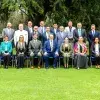David Garza | Opinion | Executive President of Tecnológico de Monterrey
* Text published on January 12th, 2025, in Times Higher Education
We enter 2025 with an unprecedented set of challenges reshaping our world. Our age is being defined by profound realignments of power, the climate crisis, and the disruptive dynamism of knowledge and technology.
A snapshot of the urgent and complex tasks ahead is provided by the United Nations’ 2024 report on progress towards its 17 United Nations Sustainable Development Goals (SDGs) – the blueprint for a more resilient and prosperous world.
We are on track to meet just 17 per cent of the targets by the deadline of 2030, and nearly half of the targets show minimal progress. More than a third have stalled or regressed.
International collaboration between universities is more vital to address this situation, pooling resources, expertise, and perspectives. But this will require a step change in existing internationalization efforts.
Student mobility and individual faculty collaboration have long been at the frontline of international engagements.
These foster a global mindset and deep bonds, creating global citizens. This is very valuable, and at Tecnológico de Monterrey, nearly 50 per cent of our students graduate with experience outside Mexico.

However, mobility is just the first layer in becoming truly international. We need to strive for much more.
International networks provide trusted environments to share perspectives on universities’ role in shaping a better future and charting the way ahead for international cooperation through institutional partnerships and research initiatives.
For example, Universitas21 brings together 29 universities from 19 countries across six continents around research, educational innovation, and student experience.
And the Association of Pacific Rim Universities (APRU) brings together 61 universities from 18 countries that focuses on areas such as disaster risk reduction, global health, and sustainable cities.
Building meaningful partnerships goes beyond signing MOUs. It requires alignment of expectations, complementary value propositions, and the commitment of resources and effort.
The most impactful relationships involve strategic alliances that contribute to the various partners’ own initiatives by leveraging collective strengths, forming networks and platforms that encourage collaboration, supporting shared resources and knowledge exchange, and amplifying impact.
Joint international research projects that leverage diverse expertise have the potential to attract grants from organizations like Horizon Europe or the US National Institutes of Health (NIH).
A study published by Elsevier indicates that the scientific impact of international collaborations is 52 per cent above the global average. Studies also show that co-authored articles are more frequently cited, indicating higher impact and relevance.
The recently adopted UN intergovernmental “Pact for the Future” is designed to promote progress by strengthening multilateral cooperation and global governance fit for future generations.
It seeks more significant support from the Global North to assist the Global South in areas related to climate action, technology transfer, and capacity-building, among other things. It highlights the critical role of partnership, particularly in science, technology, and digital collaboration.
According to the OECD, nearly 20 per cent of research articles worldwide are already coauthored by international participants. At Tec de Monterrey, this number is 50 per cent. But we think it needs to be higher still.
As recently experienced with Covid-19, healthcare challenges and public health crises need comprehensive solutions that isolated efforts cannot achieve. Cross-border partnerships allow researchers to compare systems, identify best practices, and tailor strategies to local contexts.
That is why we have recently signed a collaboration agreement with the Ragon Institute of Boston’s Mass General Brigham health system, MIT, and Harvard. This partnership integrates the expertise of top US research institutions with Tec’s innovative capacities, offering the potential to apply breakthrough discoveries to Latin America.
By combining research excellence and capacity building with regional know-how, such collaborations can accelerate the discovery and deployment of innovative solutions.
Tec envisions our collaboration with the Ragon Institute as a foundation for broader partnerships that connect Latin America to global research centers of excellence.
It can also be a model for broader collaborations between institutions in rich countries and those in low- and middleincome countries, which are afflicted by globally relevant challenges such as health, economic development, and climate change.
Universities have the capacity and inclination for innovation, long-term thinking, interdisciplinary, and multicultural collaboration.
They can reimagine the future like no other institution or platform can. If universities in the Global North collaborate with research initiatives in the Global South to address their greatest challenges, the potential for regional impact is tremendous.
* David Garza is president of Tecnológico de Monterrey. He is chair of Universitas 21, a member of the steering committee of Association of Pacific Rim Universities (APRU) and has been a member of the Board of Trustees of the USA accreditor SACSCOC. david@tec.mx | @david_garza





